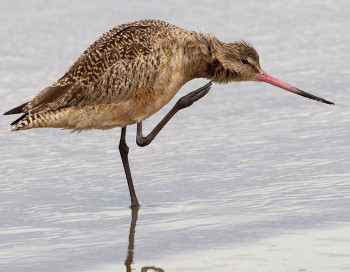Scratch

One thing you don’t have to think about when the back of your neck itches is whether to lift your foot over your shoulder to scratch with your toes or not. But if you were a hummingbird, that is exactly what you would do; bring that tiny leg up over your wing to let those neat little claws rake so satisfyingly into the head feathers where perhaps a mite or some other unwanted citizen is asking to be removed. A hawk or heron, on the other hand, will reach under the wing and then up to scratch. And, oh! Such a relief it is.
When you consider it, itching really does have its function: annoyance, to be exact. It’s a call to action, isn’t it? And if you are a bird, you may well have a great deal to scratch about. Mites and fleas, to name a couple. Some like feather mites, which feed on the debris of dead skin cells or feather, are not a threat to the bird unless in unusually large number. But many of the others feed on blood or, like nasal mites, live in odd places, certainly pests worthy of a thorough cleaning out. Scratch! Scratch!
The life cycles of these parasites can be quite complex, sometimes so much so as to be adapted to a single bird species or a small group of closely related birds. Bird lice in the suborder Mallophaga may be so specialized that they draw their sustenance only from developing feathers and even lay their eggs within the host’s feather shafts. There are even cases where taxonomic relationships between birds have been suggested by looking at the species of bird lice parasitizing them. Oh, yes! Scratch right there.
One of the oddest creatures that lives on birds is the louse fly. Such a lovely name, isn’t it? These moderately-sized flies are flattened so that they can slide rapidly through a bird’s plumage to avoid those scratching claws. Louse flies feed on blood, but their main threat to the bird is through diseases they may carry between birds. They have a life cycle quite unusual for an insect in that the female fly carries a single developing larva inside itself, finally giving birth to a fully formed fly before letting another egg begin development.
Fortunately, most birds are healthy enough that their preening can keep this nasty plethora of parasites under control. So whether they reach over or under the wing to scratch, while a matter of curiosity to us inquiring birders, is only a matter of convenience to the bird itself. It’s got an itch and a pretty good idea of just what to do about it. Scrrraaatch!


